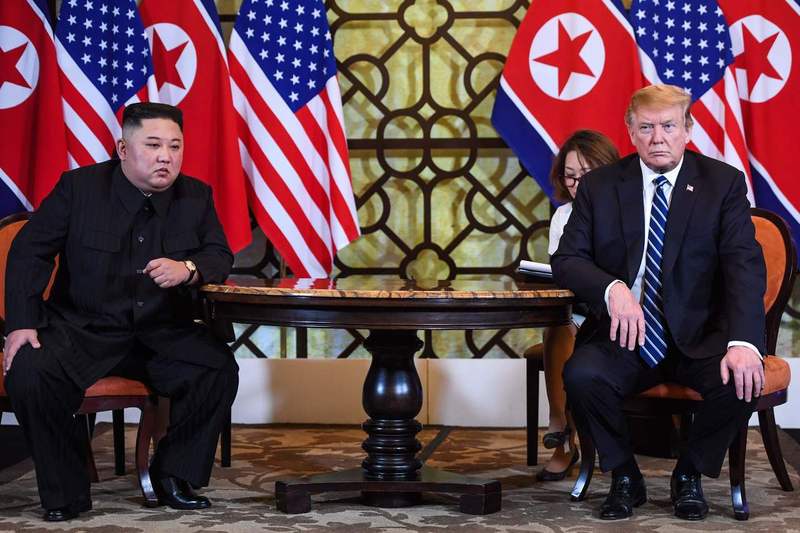 |
|
North Korean leader Kim Jong-un and US President Donald Trump at the Sofitel Legend Metropole Hanoi hotel on Feb. 28.
|
Resolving hostilities between two countries has always been a long, arduous process
The Hanoi summit between North Korean leader Kim Jong-un and US President Donald Trump ended in failure. There was no solemn signing ceremony, no lavish press conference. The reversal made a mockery of predictions, which right up until the event saw it producing some kind of major or minor outcome. I have to wonder what expressions went across the two men’s faces the moment they realized they were not going to be able to reach an agreement then and there. They are said to have been smiling as they parted ways – but those smiles were probably not the real thing. In the wake of Hanoi’s failure, skepticism over the top-down approach to North Korea-US summits has been rearing its head. The Hanoi summit, it is being argued, offered clear proof of the risks when summit diplomacy is dependent on the decisions of top leaders. Indeed, there aren’t any measures available when leaders meet and scuffle. That’s why some are calling for a return to the “recipe for success”: working-level negotiators wracking their brains in discussions, with the leaders elegantly sweeping in to sign the summit agreement. The rewards and risks of climbing a mountaintop But summits are inherently a risky proposition. The word “summit” was first brought into the diplomatic vocabulary by Winston Churchill. In Feb. 1950, when the Cold War was raging, he proposed “another talk with the Soviet Union at the highest level,” which he referred to as “the summit.” He was likening a meeting among the top leaders of hostile countries to an encounter on a mountain peak. It was “not easy to see how matters could be worsened by a parley at the summit,” he argued. A mountaintop is difficult to reach, but it’s also difficult to get down from. While you may enjoy the pleasure of planting a flag of conquest, one false step could leave you facing an agonizing fall. The only option at a summit is to wager everything you have – a grand form of diplomacy, but also a perilous one. Churchill is said to have gotten the idea for a “parley at the summit” from the worldwide craze at the time for climbing Mt. Everest. Kim himself may have offered the best expression of the summit’s allure. He boarded a personal train that traveled 66 hours from Pyongyang to Hanoi. His journey took him past the mountains and rivers of China – reminiscent of a climb up Everest’s slopes. When Kim told Trump in their meeting that he had “walked here to Hanoi,” and that the process had “demanded a lot of thought, effort, and perseverance,” he was not speaking in analogy but giving a straightforward description. During the first North Korea-US summit in Singapore, he had said, “Though our eyes and ears are sometimes blocked by mistaken preconceptions and practices, I have overcome all of that to arrive here.” Kim and Trump parted ways without the promise of another meeting. Questioned when the next summit would be held during a press conference shortly after the failure to reach an agreement, Trump replied, “It might be soon, it might not be for a long time.” It’s a response that foreshadows more thought, effort, and perseverance toward the next summit after Hanoi. The failure of the 1961 Vienna summit and the success of the 1985 Geneva summit The 1961 US-Soviet summit in Vienna is considered one of the worst failures in diplomatic history. The ambitious US President John F. Kennedy went into his meeting with belligerent Soviet leader Nikita Khrushchev amid the Berlin blockade and the threat of nuclear war. Shortly before the summit, Kennedy confidently proclaimed, “It is far better that we meet at the summit than at the brink.” But the mood at the summit was frosty. Throughout the summit, Kennedy suffered through an ideological onslaught from Khrushchev, who insisted that communism would prevail over capitalism. Kennedy despaired at how Khrushchev was approaching it. After the Vienna fiasco, diplomats were skeptical of the usefulness of the summit framework. They had gained a newfound awareness of the dangers of holding summits when such serious differences in opinion are present. But the US was subsequently drawn into the Vietnam War quagmire, while the need for summits was increasingly raised in the Soviet Union, which was sensing the limits of the nuclear arms race. After the experience of the Cuban Missile Crisis, the US and Soviet Union finally met again in Moscow in 1972 and signed the Strategic Arms Limitation Talks (SALT) agreement. It was a huge step forward – one that heralded the Geneva summit in 1985, which would be a turning point toward the end of the US-Soviet Cold War. Summits do not yield success all at once. The Cold War between the US and Soviet Union was resolved slowly, over the course of four different decisive summits. It took 40 years: from Yalta in 1945 to Vienna in 1961, Moscow in 1972, and Geneva in 1985. The process was marked by both failures and successes. The only way to overcome the risks of summits lies in continuity. By Yoo Kang-moon, senior staff writer Please direct comments or questions to [english@hani.co.kr]






